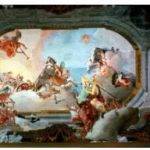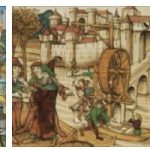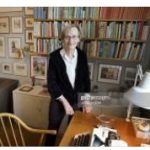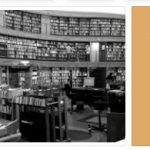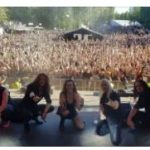Architecture
During the period of freedom (Frihetstiden, 1718–72), local artists increasingly took the place of foreign artists. Hardly any other architect shaped the art of the period of freedom and the period that followed as much as C. Hårleman. With Svartsjö Castle in Uppland (from 1735), the first example of French-inspired Rococo, he laid the basis for one of the most important building traditions in Swedish architectural history; important were among others. also his designs for Övedskloster Palace in Skåne (from 1753–76) and the toll bridge in Falkenberg (early 1750s). The architects (including Hårleman, J. E. Rehn) also dealt with v. a. with the interiors of castles and country houses in the spirit of the French Rococo, which they had appropriated through studies in Paris. Church construction still followed the ideal of the Baroque (de la Vallée, N. Tessin the Elder and the Younger). Carl Frederik Adelcrantz (* 1716, † 1796) was the most influential architect at the turn from Rococo to Classicism (Castle Theater in Drottningholm Palace Park, 1764–66; Chinese Castle, ibid., 1763–68; Adolf Friedrich Church in Stockholm, 1768–83).
The “Gustavian” (“gustaviansk”), named after Gustav III, with its classicistic tendencies, is an epoch of its own. E. Palmstedt built the intimate Palladian theater for him in 1782 in one of the round towers of Gripsholm Castle. In 1784 the king calledL. J. Desprez to Sweden as a set designer and architect, where he introduced contemporary architecture in the style of French architecture at the time of the Revolution (Botanicum in Uppsala, 1793, with Tempelman. 1794 with the establishment of a public museum for the royal collections the foundation for the National Museum (founded in 1866) was laid.
Plastic
In the field of sculpture, the French initially dominated (Jacques Philippe Bouchardon, * 1711, † 1753; Pierre Hubert L’Archevêque, * 1721, † 1778); It was not until the end of the 18th century that a Swedish artist of international standing appeared in J. T. Sergel. He created portraits, mythological figures and monuments in a classicist style still animated by the sensualism of the Rococo.
Painting
In the 18th century, Swedish painters even achieved success in Paris: A. Roslin with elegant portraits, P. A. Hall with miniature paintings, N. Lafrensen the Younger with depictions of fashionable society and G. Lundberg with pastel portraits. The most important Rococo painter and outstanding colorist, C. G. Pilo, also worked for the Danish royal family. P. Hilleström painted rural and middle-class genre scenes; E. Martin, who was trained in England, created the first landscape pictures and vedute of Swedish painting. Elegant portraits with striking grace in the manner of T. Gainsborough and J. Reynolds created by Carl Fredrik von Breda (* 1759, † 1818).
Handicrafts
Swedish handicrafts also reached a high level in the 18th century, v. a. in gold and silversmithing (Gustaf Stafhell the Elder, * 1683, † 1761; Per Zethelius, * 1740, † 1810), in porcelain production (Rörstrand manufactories since 1726, Marieberg since 1758) and in furniture production (Christian Linning, * 1714, † 1779; Georg Haupt, * 1741, † 1784).
19th century
Architecture
After the death of Gustav III. In 1792 the arts received little support for a long time. Until the middle of the 19th century, the architecture remained largely classical (Karl-Johann-Zeit, 1810–44). Only now did the Middle Ages, Renaissance and Baroque periods begin to be exhausted as a reserve of forms; important representatives of this direction are Frederik Wilhelm Scholander (* 1816, † 1881; old technical college, 1863; synagogue, 1870; both in Stockholm) and Helgo Zettervall (* 1831, † 1907; university building in Lund, 1882; Oscar Fredriks Church in Gothenburg, 1893). The central churches of Emil Victor Langlet (* 1824, † 1898; i.a. Caroli, 1879/80; Sankt Pauli, 1889–82, both in Malmö). With the restoration of the cathedral in Lund by CG Brunius and H. Zettervall, the long controversial, but now also positively rated, cathedral restoration began. Towards the end of the 19th century, the architects remembered local traditions and materials; The transition to national romanticism or material realism at the church of Lysekil (Bohuslän province; 1901, by Adrian Crispin Peterson, * 1835, † 1912) is still hesitant.
Plastic
The sculpture was initially shaped by classicism and was replaced by national tendencies in the course of the century. Of importance are Johan Niklas Byström (* 1783, † 1848) with his elegant classicism, B. E. Fogelberg with sculptures from Nordic mythology, Erik Gustaf Göthe (* 1779, † 1838) with ambitious park and cemetery monuments and Gustaf Qvarnström (* 1810, † 1867) with sculptures inspired by the Renaissance. In Paris, Per Hasselberg (* 1849, † 1894) joined naturalism; The younger generation of sculptors (C. Eriksson, C. Eldh et al.) also showed themselves to be influenced by French.
Painting
According to ezinereligion, Romantic painting is only weakly represented in Sweden (C. J. Fahlcrantz; Nils Jakob Blommér, * 1816, † 1853; J. A. Malmström; P. Krafft the Younger; Johann Gustaf Sandberg, * 1782, † 1854; Fredric Westin, * 1782, † 1862). From around 1850 many painters studied in Düsseldorf and cultivated the genre painting there, which put them in a Nordic milieu (B. Nordenberg; Ferdinand Fagerlin, * 1825, † 1907). Landscape painters such as S. M. Larsson, who tends to be dramatic, and Johan Edvard Bergh (* 1828, † 1880), who tends to be idyllic were inspired by the Düsseldorf school. Some history painters turned to Paris, Munich or Rome (Mårten Eskil Winge, * 1825, † 1896; Carl Wahlbom, * 1810, † 1858; Carl Gustav Hellquist, * 1851, † 1890, etc.). After 1880, the Swedish painters oriented themselves primarily to Paris. An artist colony was established in Grez-sur-Loing near Fontainebleau; it helped open-air painting to make its breakthrough. Great talents of this generation were the figure painter and portraitist E. Josephson and the landscape painter C. F. Hill. Internationally known painters at the turn of the century are A. Zorn, who was also excellent as an eraser and who worked more decoratively C. Larsson, the animal painter B. Liljefors and the landscape painter Prinz Eugen Bernadotte (* 1865, † 1947). The best works from the 1890s are filled with that special Nordic light between day and dusk, a peculiarity of Scandinavian mood painting (e.g. the painters of the Varberg School SR Bergh ; N. Kreuger ; K. Nordström).

